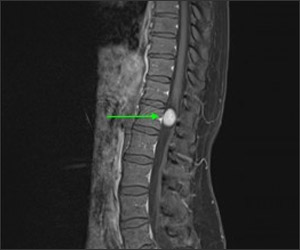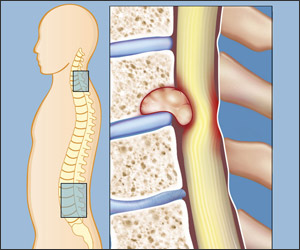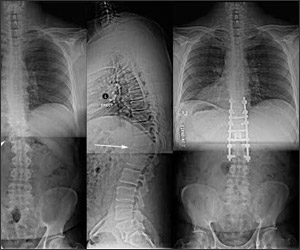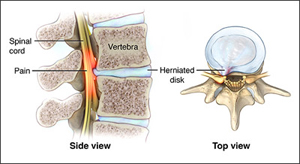
Dr. Amitabha Das
MBBS (Hons), MS (General Surgery, Gold medalist), MCh (Neurosurgery, AIIMS

MBBS (Hons), MS (General Surgery, Gold medalist), MCh (Neurosurgery, AIIMS
spinal tumour
What is a spinal tumour?
A spinal tumour is an abnormal growth of cells in the spine.
If cells in the spine grow and multiply abnormally to cause a spinal tumour, this is called a primary tumour.
If abnormal cells have spread to the spine from a tumour in another part of the body, this is called a secondary tumour or a metastasis (‘secondaries’ or metastases when talking about more than one).
 2
2
What are the different types of spinal tumours and where do they occur?
Primary tumours are graded by doctors according to the speed at which they are growing. Slower-growing tumours are given lower grades (grades 1 and 2) and faster-growing tumours are given higher grades (grades 3 and 4).
The grading system was devised by the World Health Organisation.
Depending on the grade, doctors will refer to a tumour as being ‘non-malignant’ or ‘malignant’. The grade of a tumour will also help doctors to decide on the most appropriate treatment.

A) Non-malignant Spinal Tumours
Low grade spinal tumours can grow but they do not spread and they do not cause secondary tumours to grow in other parts of the body. However, these tumours can grow to a considerable size, causing damage by putting pressure on the tissue around them in the spine.
Historically, the term ‘benign’ has been used to refer to grade 1 and grade 2 spinal tumours. However, increasingly this term is not being used. This is because, by definition, a ‘benign condition’ is one that doesn’t cause harm whereas in fact all spinal tumours have the potential to cause significant harm, even if they are slow growing and less aggressive when they are discovered. In this publication, we will use the term ‘non-malignant’ to describe low grade spinal tumours.
B) Malignant Spinal Tumours
High grade spinal tumours are referred to as ‘malignant’ spinal tumours. Malignant spinal tumours are cancerous. They do spread and destroy the tissue surrounding them. The rate at which they invade the surrounding tissue depends on how malignant they are. They can also cause tumours to grow in other parts of the body, although this is unusual for spinal cord tumours.
 Primary spinal tumours can be non-malignant or malignant depending on their grade. Doctors do not grade secondary (metastatic) spinal tumours because, having spread from a malignant tumour elsewhere in the body, they are always malignant.
The most common spinal tumours are malignant metastases that have spread to the spine from malignant primary tumours in other parts of the body.
Malignant primary tumours in the prostate, breasts, lungs, kidneys and bowel are the most common sources of malignant metastases in the spine.
Primary spinal tumours can be non-malignant or malignant depending on their grade. Doctors do not grade secondary (metastatic) spinal tumours because, having spread from a malignant tumour elsewhere in the body, they are always malignant.
The most common spinal tumours are malignant metastases that have spread to the spine from malignant primary tumours in other parts of the body.
Malignant primary tumours in the prostate, breasts, lungs, kidneys and bowel are the most common sources of malignant metastases in the spine.
The brain and spinal cord are covered by a protective outer membrane (a layer or a ‘skin’) called the dura. Tumours that occur outside the dura are called extradural tumours. Tumours can also occur inside the dura (non-malignant spinal tumours usually occur inside the dura). Tumours that occur inside the dura but outside of the spinal cord are called intradural extramedullary tumours. Less commonly, tumours can grow inside the spinal cord itself. These are called intramedullary tumours.
Any section of the spine can be affected by tumours, from the top of the neck down to the coccyx (tail bone).
Secondary (metastatic) tumours in the bone are the most common type of spinal tumour. Primary bone tumours are rare.
What causes Spinal Tumours?
We do not yet know what causes primary spinal tumours and we do not know why some are malignant and some are not.
Secondary (metastatic) spinal tumours are always caused by a cancerous tumour spreading from another part of the body.
What are the symptoms of a Spinal Tumour?
The symptoms of a spinal tumour depend on factors such as the size of the tumour, its exact location within the spine and which section of the spine is affected.
People might not experience all of the main symptoms of a spinal tumour but they are likely to experience more than one of them.
 A) Back Pain
A) Back Pain
The most commonly experienced symptom of a spinal tumour is pain in or near the spine. Often the pain is not relieved by resting and it might get worse when you lie down or go to bed. Pain that starts in the back before radiating around the body is a sign that nerves could be affected. This type of radiating pain might be caused by a tumour but it is not necessarily the case. Pain spreading down an arm or leg from the spine is a common symptom of a slipped disc.
Spinal tumours are rare and it is important to note that aches in the neck or general backache are most likely to be due to wear and tear in the joints or discs or caused by a problem like a slipped disc.
 Worsening numbness, tingling, weakness or paralysis (inability to move) of the arms or the legs should be taken seriously. Sometimes these symptoms can be experienced in both arms as well as both legs. This is a possible sign of a problem in the cervical section of the spine (the neck).
Worsening numbness, tingling, weakness or paralysis (inability to move) of the arms or the legs should be taken seriously. Sometimes these symptoms can be experienced in both arms as well as both legs. This is a possible sign of a problem in the cervical section of the spine (the neck).